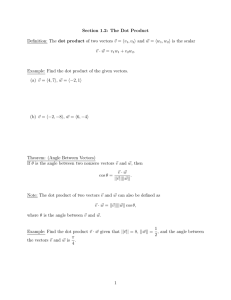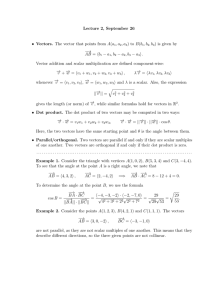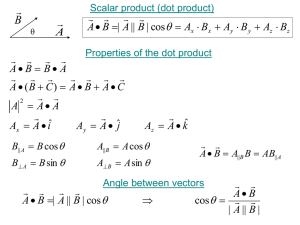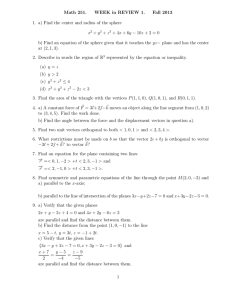Document 13403704
advertisement
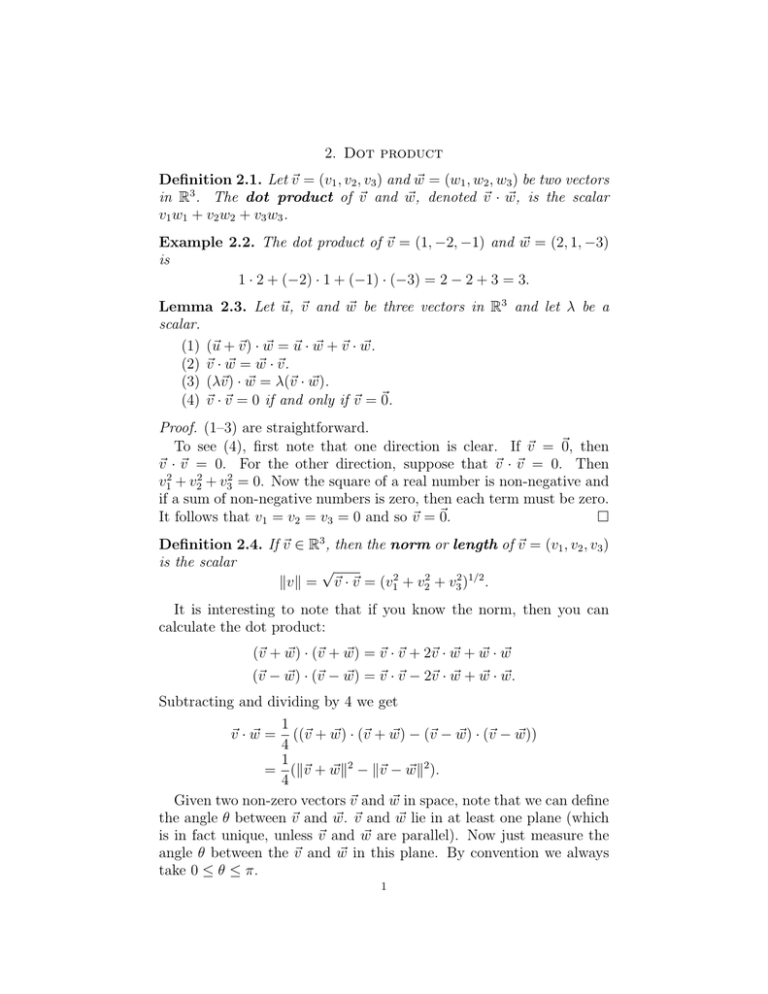
2. Dot product Definition 2.1. Let �v = (v1 , v2 , v3 ) and w � = (w1 , w2 , w3 ) be two vectors 3 � , denoted �v · w � , is the scalar in R . The dot product of �v and w v1 w1 + v2 w2 + v3 w3 . Example 2.2. The dot product of �v = (1, −2, −1) and w � = (2, 1, −3) is 1 · 2 + (−2) · 1 + (−1) · (−3) = 2 − 2 + 3 = 3. Lemma 2.3. Let �u, �v and w � be three vectors in R3 and let λ be a scalar. (1) (�u + �v ) · w � = �u · w � + �v · w �. (2) �v · w � =w � · �v . (3) (λ�v ) · w � = λ(�v · w � ). (4) �v· �v = 0 if and only if �v = �0. Proof. (1–3) are straightforward. To see (4), first note that one direction is clear. If �v = �0, then �v ·�v = 0. For the other direction, suppose that �v · �v = 0. Then v12 + v22 + v32 = 0. Now the square of a real number is non-negative and if a sum of non-negative numbers is zero, then each term must be zero. It follows that v1 = v2 = v3 = 0 and so �v = �0. � Definition 2.4. If �v ∈ R3 , then the norm or length of �v = (v1 , v2 , v3 ) is the scalar √ �v� = �v · �v = (v12 + v22 + v32 )1/2 . It is interesting to note that if you know the norm, then you can calculate the dot product: (�v + w � ) · (�v + w � ) = �v · �v + 2�v · w � +w � ·w � (�v − w � ) · (�v − w � ) = �v · �v − 2�v · w � +w � · w. � Subtracting and dividing by 4 we get 1 �v ·w � = ((�v + w � ) · (�v + w � ) − (�v − w � ) · (�v − w � )) 4 1 = (��v + w � �2 − ��v − w � �2 ). 4 Given two non-zero vectors �v and w � in space, note that we can define the angle θ between �v and w � . �v and w � lie in at least one plane (which is in fact unique, unless �v and w � are parallel). Now just measure the angle θ between the �v and w � in this plane. By convention we always take 0 ≤ θ ≤ π. 1 Theorem 2.5. If �v and w � are any two vectors in R3 , then �v · w � = ��v � �w � � cos θ. Proof. If �v is the zero vector, then both sides are equal to zero, so that they are equal to each other and the formula holds (note though, that in this case the angle θ is not determined). By symmetry, we may assume that �v and w � are both non-zero. Let �u = w � −�v and apply the law of cosines to the triangle with sides parallel to �u, �v and w �: ��u�2 = ��v �2 + �w � �2 − 2��v ��w � � cos θ. We have already seen that the LHS of this equation expands to �v · �v − 2�v · w � +w � ·w � = ��v �2 − 2�v · w � + �w � �. � �2 from both sides, and Cancelling the common terms ��v �2 and �w dividing by 2, we get the desired formula. � We can use (2.5) to find the angle between two vectors: Example 2.6. Let �v = −ı̂ + k̂ and w � = ı̂ + ĵ. Then −1 = �v · w � = ��v ��w � � cos θ = 2 cos θ. Therefore cos θ = −1/2 and so θ = 2π/3. Definition 2.7. We say that two vectors �v and w � in R3 are orthog­ onal if �v · w � = 0. Remark 2.8. If neither �v nor w � are the zero vector, and �v · w � = 0 then the angle between �v and w � is a right angle. Our convention is that the zero vector is orthogonal to every vector. Example 2.9. ı̂, ĵ and k̂ are pairwise orthogonal. Given two vectors �v and w � , we can project �v onto w � . The resulting vector is called the projection of �v onto w � and is denoted projw� �v . For � � is a direction, then the projection of F� example, if F is a force and w onto w � is the force in the direction of w �. As projw� �v is parallel to w � , we have projw� �v = λw, � for some scalar λ. Let’s determine λ. Let’s deal with the case that � is between 0 and π/2). If λ ≥ 0 (so that the angle θ between �v and w we take the norm of both sides, we get � projw� �v � = �λw� � = λ�w � �, 2 (note that λ ≥ 0), so that λ= � projw� �v � . �w �� But cos θ = � projw� �v � , ��v � so that � projw� �v � = ��v � cos θ. Putting all of this together we get ��v � cos θ �w � � ��v ��w � � cos θ = �w � �2 �v · w � = . �w � �2 λ= There are a number of ways to deal with the case when λ < 0 (so that θ > π/2). One can carry out a similar analysis to the one given above. Here is another way. Note that the angle φ between w � and �u = −�v is equal to π − θ < π/2. By what we already proved projw� �u = �u · w � w. � �w � �2 But projw� �u = − projw� �v and �u · w � = −�v · w � , so we get the same formula in the end. To summarise: Theorem 2.10. If �v and w � are two vectors in R3 , where w � is not zero, then � � �v · w � projw� �v = w. � �w � �2 Example 2.11. Find the distance d between the line l containing the points P1 = (1, −1, 2) and P2 = (4, 1, 0) and the point Q = (3, 2, 4). Suppose that R is the closest point on the line l to the point Q. Note −−→ −→ that QR is orthogonal to the direction P1 P2 of the line. So we want the −− −− −−→ P Q, that is, we want length of the vector P1 Q − proj− P1 P2 1 −− −− −−→ P Q�. d = �P1 Q − proj− P1 P2 1 Now −−→ P1 Q = (2, 3, 2) and 3 −−→ P1 P2 = (3, 2, −2). We have −−→ �P1 P2 �2 = 32 + 22 + 22 = 17 It follows that and −−→ −−→ P1 P2 · P1 Q = 6 + 6 − 4 = 8. −−→ 8 −−→ P Q = proj− (3, 2, −2). P1 P2 1 17 Subtracting, we get −−→ −−→ 8 1 5 −−→ P Q = (2, 3, 2)− P1 Q−proj− (3, 2, −2) = (10, 35, 50) = (2, 7, 10). P1 P2 1 17 17 17 Taking the length, we get 5 2 (2 + 72 + 102 )1/2 ≈ 3.64. 17 Theorem 2.12. The angle subtended on the circumference of a circle by a diameter of the circle is always a right angle. Proof. Suppose that P and Q are the two endpoints of a diameter of the circle and that R is a point on the circumference. We want to show −→ −→ that the angle between P R and QR is a right angle. Let O be the centre of the circle. Then −→ −→ −→ −→ −→ −→ and QR = QO + OR. P R = P O + OR −→ −→ Note that QO = −P O. Therefore −→ −→ −→ −→ −→ −→ P R · QR = (P O + OR) · (QO + OR) −→ −→ −→ −→ = (P O + OR) · (OR − P O) −−→ −→ = �OR�2 − �P O�2 = r2 − r2 = 0, −→ −→ where r is the radius of the circle. It follows that P R and QR are indeed orthogonal. � 4 MIT OpenCourseWare http://ocw.mit.edu 18.022 Calculus of Several Variables Fall 2010 For information about citing these materials or our Terms of Use, visit: http://ocw.mit.edu/terms.
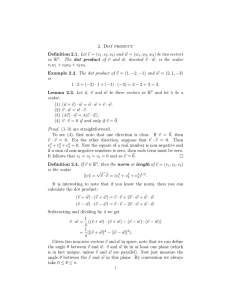
![1S2 (Timoney) Tutorial sheet 4 [November 14 – 19, 2007] Name: Solutions](http://s2.studylib.net/store/data/011011718_1-f618912eae29e82f5106ba921923fb09-300x300.png)

